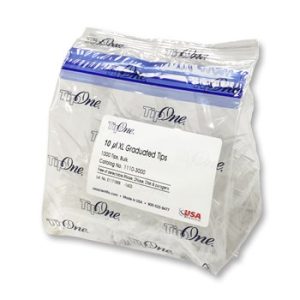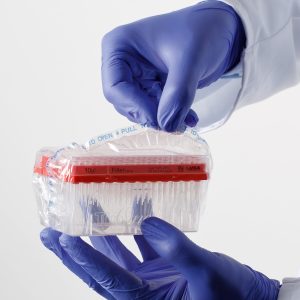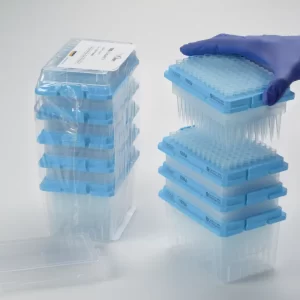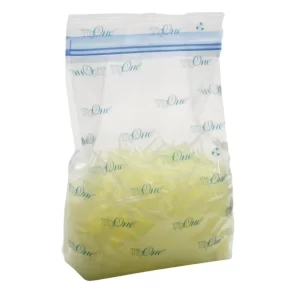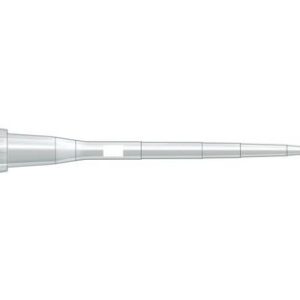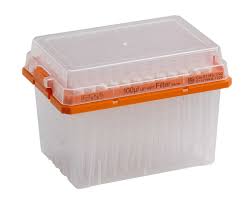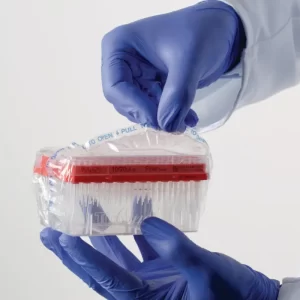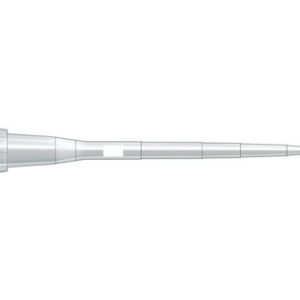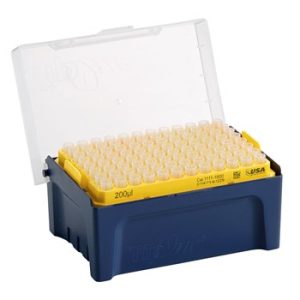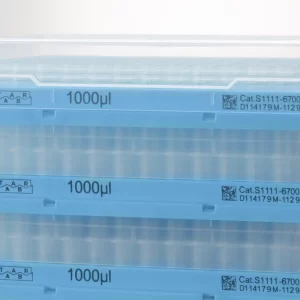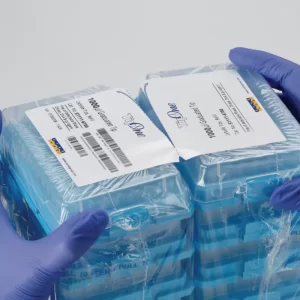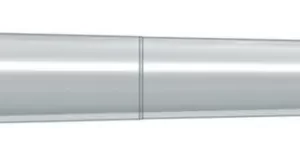TipOne 10 µl Graduated Tip, Natural, Bulk
Universal fit: One tip fits all! The tip collar is engineered to fit all popular pipettes
Manufacture: The use of multiple cavity tools for the injection moulding process guarantees high conformity within one batch. The automated moulding and assembling procedures are carried out under clean-room conditions to eliminate contamination.
Highly polished moulds: For an extremely smooth surface to reduce sample retention
Material: All TipOne tips are manufactured from pure, virgin polypropylene to ensure the highest quality product.
Certified: Every TipOne product is certified Rnase, Dnase, DNA and Pyrogen free. Convenient self-standing resealable bags.
UltraPoint thin-wall orifice helps prevent sample hang up and makes it easier to touch off the last drop of sample (only in UltraPoint tips)
TipOne 10 µl Graduated Tip, Natural, Refill
Separating the refill: The two-part label can be easily split into two, individually sealed stacks.
Removing wafers from the refill: Remove the protective film and lift the top wafer, including the top shell, off the stack. Use the finger tabs on either end of the water will lift too.
Refill the rack: It's so easy! Simply place the wafer, top shell and spacer into an empty rack and click securely in place. The top shell can either remain inside the rack for extra protection or transferred back to the top layer of the open refill if not racking all five at the same time.
Close the lid, refilling is complete: Refilling a rack takes only seconds. The refilled rack can now be used or autoclaved, depending on your application.
Recover the partially used stack: The remaining tips of the refill can be protected from contamination by replacing the top shell. There's no need to remove the bottom shell when using the last wafer. Both the bottom shell and the wafer fits inside the new rack.
TipOne 10/20 µl Graduated Tip, Natural, Bulk
Universal fit: One tip fits all! The tip collar is engineered to fit all popular pipettes
Manufacture: The use of multiple cavity tools for the injection moulding process guarantees high conformity within one batch. The automated moulding and assembling procedures are carried out under clean-room conditions to eliminate contamination.
Highly polished moulds: For an extremely smooth surface to reduce sample retention
Material: All TipOne tips are manufactured from pure, virgin polypropylene to ensure the highest quality product.
Certified: Every TipOne product is certified Rnase, Dnase, DNA and Pyrogen free. Convenient self-standing resealable bags.
UltraPoint thin-wall orifice helps prevent sample hang up and makes it easier to touch off the last drop of sample (only in UltraPoint tips)
TipOne 10/20 µL RPT XL Graduated Filter Tip (Sterile)
TipOne ® RPT(Repel Polymer Technology)
Most Companies use a siliconization, fluoidation and the formation of a wax layer for the manufacture of “Low Retention” tips.
All have one major drawback: as an additional layer is formed on the surface of the PP which is not firmly connected to the PP at an atomic level there is, for instance, a risk of bleeding and, consequently, contamination of the sample.
In contrast, the “Repel Polymer Technology”(RPT) optimises the plastic surface using molecular hydrophobising. The entire tip has the same excellent properties and has a 3x lower surface energy than Teflon (PTFE). This complex and highly innovative method creates an invisible superhydrophobic surface which cannot bleed due to its covalent bond. This prevents contamination or negative cross reactions in experiments. It also produces less foam.
Why RPT?
You know how it is: a Lysis buffer needs to be prepared and, annoyingly, the Triton X-100 cannot be pipetted properly.
You are also experiencing problems with the pipetting of Tween or glycerine? You can, of course, pipette very, very slowly, but many users have resorted to cutting the pipette tips to create a larger opening. However, not only is this complicated it can also lead to contamination.
Using pipette tips with special surface properties offers a practical solution to this problem. The objective is to create a surface that is as hydrophobic and smooth as possible to ensure that no liquid is retained in the tip. In this context, this is also referred to as “Low Retention” tips.
TipOne ® RPT vs. standard tip
To find out how TipOne ®RPT tips perform when compared to standard tips, different solutions with liquids with “critical” flow properties were prepared and pipetted using 200 μL RPT tips and/or standard tips. It was determined how much liquid runs back out of the tip.
When TipOne ® RPT tips are used, sample losses are lower. The more viscous/concentrated the pipetted liquid, the greater the difference is between standard tips and RPT tips.
TipOne 10/20 µL RPT XL Graduated Filter Tip (Sterile)
TipOne ® RPT(Repel Polymer Technology)
Most Companies use a siliconization, fluoidation and the formation of a wax layer for the manufacture of “Low Retention” tips.
All have one major drawback: as an additional layer is formed on the surface of the PP which is not firmly connected to the PP at an atomic level there is, for instance, a risk of bleeding and, consequently, contamination of the sample.
In contrast, the “Repel Polymer Technology”(RPT) optimises the plastic surface using molecular hydrophobising. The entire tip has the same excellent properties and has a 3x lower surface energy than Teflon (PTFE). This complex and highly innovative method creates an invisible superhydrophobic surface which cannot bleed due to its covalent bond. This prevents contamination or negative cross reactions in experiments. It also produces less foam.
Why RPT?
You know how it is: a Lysis buffer needs to be prepared and, annoyingly, the Triton X-100 cannot be pipetted properly.
You are also experiencing problems with the pipetting of Tween or glycerine? You can, of course, pipette very, very slowly, but many users have resorted to cutting the pipette tips to create a larger opening. However, not only is this complicated it can also lead to contamination.
Using pipette tips with special surface properties offers a practical solution to this problem. The objective is to create a surface that is as hydrophobic and smooth as possible to ensure that no liquid is retained in the tip. In this context, this is also referred to as “Low Retention” tips.
TipOne ® RPT vs. standard tip
To find out how TipOne ®RPT tips perform when compared to standard tips, different solutions with liquids with “critical” flow properties were prepared and pipetted using 200 μL RPT tips and/or standard tips. It was determined how much liquid runs back out of the tip.
When TipOne ® RPT tips are used, sample losses are lower. The more viscous/concentrated the pipetted liquid, the greater the difference is between standard tips and RPT tips.
TipOne 10/20 µl XL Graduated Tip, Natural, Refill
Separating the refill: The two-part label can be easily split into two, individually sealed stacks.
Removing wafers from the refill: Remove the protective film and lift the top wafer, including the top shell, off the stack. Use the finger tabs on either end of the water will lift too.
Refill the rack: It’s so easy! Simply place the wafer, top shell and spacer into an empty rack and click securely in place. The top shell can either remain inside the rack for extra protection or transferred back to the top layer of the open refill if not racking all five at the same time.
Close the lid, refilling is complete: Refilling a rack takes only seconds. The refilled rack can now be used or autoclaved, depending on your application.
Recover the partially used stack: The remaining tips of the refill can be protected from contamination by replacing the top shell. There’s no need to remove the bottom shell when using the last wafer. Both the bottom shell and the wafer fits inside the new rack.
TipOne 10/20µl XL Graduated Filter Tip (Sterile)
Protect your samples against unwanted contamination by using TipOne filter tips. TipOne filter tips are proven to block >99% of aerosols and are among the best filter on the market.
Quality: Highly effective HDPE filter
Safe: Filter contains no additives to interfere with your samples
Retrieval: The filter will not absorb samples, allowing recovery if necessary
Certified: Sterile, and RNase, Dnase, DNA and Pyrogen free
UltraPoint: Thin-wall orifice helps prevent sample hang up and makes it easier to touch off the last drop of sample (only in UltraPoint tips)
TipOne 10/20µl XL Graduated Filter Tip (Sterile)
Protect your samples against unwanted contamination by using TipOne filter tips. TipOne filter tips are proven to block >99% of aerosols and are among the best filter on the market.
- Quality: Highly effective HDPE filter
- Safe: Filter contains no additives to interfere with your samples
- Retrieval: The filter will not absorb samples, allowing recovery if necessary
- Certified: Sterile, and RNase, Dnase, DNA and Pyrogen free
- UltraPoint: Thin-wall orifice helps prevent sample hang up and makes it easier to touch off the last drop of sample (only in UltraPoint tips)
TipOne 1000 µl Graduated Tip, Natural, Bulk
Universal fit: One tip fits all! The tip collar is engineered to fit all popular pipettes
Manufacture: The use of multiple cavity tools for the injection moulding process guarantees high conformity within one batch. The automated moulding and assembling procedures are carried out under clean-room conditions to eliminate contamination.
Highly polished moulds: For an extremely smooth surface to reduce sample retention
Material: All TipOne tips are manufactured from pure, virgin polypropylene to ensure the highest quality product.
Certified: Every TipOne product is certified Rnase, Dnase, DNA and Pyrogen free. Convenient self-standing resealable bags.
UltraPoint thin-wall orifice helps prevent sample hang up and makes it easier to touch off the last drop of sample (only in UltraPoint tips)
TipOne 1000 µl Graduated Tip, Natural, Refill
Separating the refill: The two-part label can be easily split into two, individually sealed stacks.
Removing wafers from the refill: Remove the protective film and lift the top wafer, including the top shell, off the stack. Use the finger tabs on either end of the water will lift too.
Refill the rack: It’s so easy! Simply place the wafer, top shell and spacer into an empty rack and click securely in place. The top shell can either remain inside the rack for extra protection or transferred back to the top layer of the open refill if not racking all five at the same time.
Close the lid, refilling is complete: Refilling a rack takes only seconds. The refilled rack can now be used or autoclaved, depending on your application.
Recover the partially used stack: The remaining tips of the refill can be protected from contamination by replacing the top shell. There’s no need to remove the bottom shell when using the last wafer. Both the bottom shell and the wafer fits inside the new rack.
TipOne 1000 µL RPT XL Graduated Filter Tip
TipOne ® RPT(Repel Polymer Technology)
Most Companies use a siliconization, fluoidation and the formation of a wax layer for the manufacture of “Low Retention” tips.
All have one major drawback: as an additional layer is formed on the surface of the PP which is not firmly connected to the PP at an atomic level there is, for instance, a risk of bleeding and, consequently, contamination of the sample.
In contrast, the “Repel Polymer Technology”(RPT) optimises the plastic surface using molecular hydrophobising. The entire tip has the same excellent properties and has a 3x lower surface energy than Teflon (PTFE). This complex and highly innovative method creates an invisible superhydrophobic surface which cannot bleed due to its covalent bond. This prevents contamination or negative cross reactions in experiments. It also produces less foam.
Why RPT?
You know how it is: a Lysis buffer needs to be prepared and, annoyingly, the Triton X-100 cannot be pipetted properly.
You are also experiencing problems with the pipetting of Tween or glycerine? You can, of course, pipette very, very slowly, but many users have resorted to cutting the pipette tips to create a larger opening. However, not only is this complicated it can also lead to contamination.
Using pipette tips with special surface properties offers a practical solution to this problem. The objective is to create a surface that is as hydrophobic and smooth as possible to ensure that no liquid is retained in the tip. In this context, this is also referred to as “Low Retention” tips.
TipOne ® RPT vs. standard tip
To find out how TipOne ®RPT tips perform when compared to standard tips, different solutions with liquids with “critical” flow properties were prepared and pipetted using 200 μL RPT tips and/or standard tips. It was determined how much liquid runs back out of the tip.
When TipOne ® RPT tips are used, sample losses are lower. The more viscous/concentrated the pipetted liquid, the greater the difference is between standard tips and RPT tips.
TipOne 1000 µL RPT XL Graduated Filter Tip
TipOne ® RPT(Repel Polymer Technology)
Most Companies use a siliconization, fluoidation and the formation of a wax layer for the manufacture of “Low Retention” tips.
All have one major drawback: as an additional layer is formed on the surface of the PP which is not firmly connected to the PP at an atomic level there is, for instance, a risk of bleeding and, consequently, contamination of the sample.
In contrast, the “Repel Polymer Technology”(RPT) optimises the plastic surface using molecular hydrophobising. The entire tip has the same excellent properties and has a 3x lower surface energy than Teflon (PTFE). This complex and highly innovative method creates an invisible superhydrophobic surface which cannot bleed due to its covalent bond. This prevents contamination or negative cross reactions in experiments. It also produces less foam.
Why RPT?
You know how it is: a Lysis buffer needs to be prepared and, annoyingly, the Triton X-100 cannot be pipetted properly.
You are also experiencing problems with the pipetting of Tween or glycerine? You can, of course, pipette very, very slowly, but many users have resorted to cutting the pipette tips to create a larger opening. However, not only is this complicated it can also lead to contamination.
Using pipette tips with special surface properties offers a practical solution to this problem. The objective is to create a surface that is as hydrophobic and smooth as possible to ensure that no liquid is retained in the tip. In this context, this is also referred to as “Low Retention” tips.
TipOne ® RPT vs. standard tip
To find out how TipOne ®RPT tips perform when compared to standard tips, different solutions with liquids with “critical” flow properties were prepared and pipetted using 200 μL RPT tips and/or standard tips. It was determined how much liquid runs back out of the tip.
When TipOne ® RPT tips are used, sample losses are lower. The more viscous/concentrated the pipetted liquid, the greater the difference is between standard tips and RPT tips.

